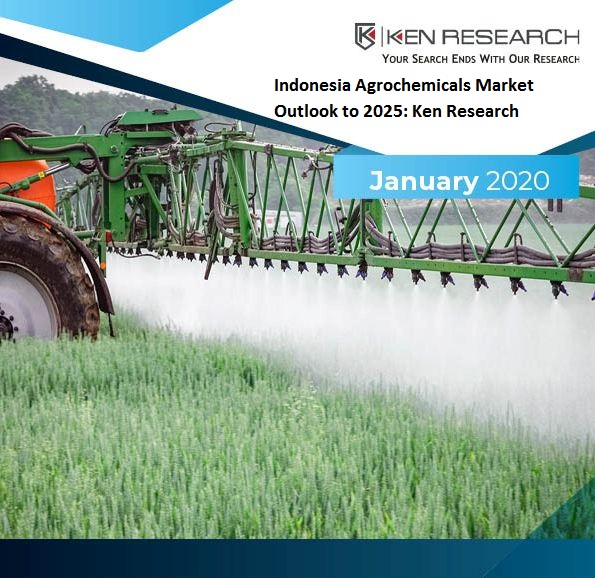Analysts at Ken Research in their latest publication “Brazil Agrochemical Market Outlook to 2025 – By Type of Pesticides (Herbicides, Insecticides, Fungicides and others), By Generic and Patented, By Form of Pesticides (Liquid, Granules and Powder), By Market Structure (Organized and Unorganized Sector), By Type of Crops (Cereal Crops, Fruit Crops and Vegetable Crops), By Region (Mato Grosso, Parana, Sao Paulo, Rio Grande do Sul and Others)” observed that the Agrochemical Market in Brazil will increase due to the rising population, increasing expenditure on R&D by major companies, rise in farming income and increasing awareness of agrochemicals among farmers coupled with rising demand of biopesticides in the country. The market is expected to register a positive CAGR of 4.9% in terms of sales revenue during the forecast period 2019P-2025F.
The ministry of Brazil estimates that soybean acreage could increase by 9.5 million acres at a growth of 26.6% by 2029 and corn acreage corn could increase by 0.7% by 2029 which will act as a growth driver for the agrochemicals market in the near future.
The agrochemicals market in Brazil is expected to witness a drive towards sustainable, cost-effective crop protection chemicals to ensure that input costs remain as low as possible due to limited financing and high operating expenses.
The Brazilian legislation of agrochemical registration is complex and very slow. Such long and complex processes increase the difficulties for overseas suppliers who have to perform additional tests and studies to get approval for selling the agrochemical within the region.
Growing Population: The rising population growth along with the increasing incomes of people as they move from low income into the middle class will increase the demand for food in Brazil due to which farmers are required to produce more food-grain in a short span of time. Thus, farmers will resort to using agrochemicals in order to increase the yield in a short span of time which will be the primary growth driver for demand of agrochemicals in the country.
Ample Unused Arable Land: According to a recent study conducted by the Brazilian agriculture ministry, there is ample unused arable land available for production of crops such as soybean. These include the Matopiba region in the north east, the Cerrado area of central Brazil and the southern fringes of the Amazonian states of Rondônia and Pará. The UN food agency estimates the world’s arable land will expand by 69 million hectares through 2050, with 49 million hectares of that growth taking place in Brazil.
Drive towards Sustainable and Cost-Effective Crop Protection: The drive for cost-effective products will favor generic companies, as they will be able to sell generic, off-patent products at low prices. They will also be able to formulate products that are more effective than international imports in a Brazilian environment; therefore, their market share is expected to increase.
Key Segments Covered
By Types of Pesticides
Herbicides
Insecticides
Fungicide
Seed Treatment
Miticides
Others
By Type of Herbicides
Glyphosate
2.4-D
Atrazine
Paraquat
Others
By Type of Fungicides
Mancozeb
Prothioconazol
Elatus
Others
By Type of Insecticides
Pyrethroids
Lambda-cyhalothrin
Chlorpyrifos
Acephate
Others
By Type of Product
Generic
Patented
By Type of Generic Products
Herbicides
Insecticides
Fungicide
Seed Treatment
Miticides
Others
By Type of Patented Products
Herbicides
Insecticides
Fungicide
Seed Treatment
Miticides
Others
By Form of Pesticide
Liquid
Granules
Powder
By Type of Market
Organized
Unorganized
By Types of Crops
Cereal Crops
Fruit Crops
Vegetable Crops
Others
By Type of Cereal Crops
Soybean
Sugarcane
Corn
Cotton
Others
By Type of Fruit Crops
Coffee
Citrus
Apples
Grapes
Others
By Type of Vegetable Crops
Potato
Tomato
Onion
Garlic
Others
By Region
Mato Grosso
Parana
Sao Paulo
Rio Grande do Sul
Others
Key Target Audience
Venture Capitalist Firms
Agrochemical Manufacturers
Raw Material Suppliers
Research & Development Institutes
Government Bodies & Regulating Authorities
Time Period Captured in the Report:
Historical Period: 2013-2019P
Forecast Period: 2019P-2025F
Companies Covered:
Syngenta
Bayer Ag
Corteva
BASF
FMC
UPL
Nufarm
Ihara Brazil
Key Topics Covered in the Report
Brazil Agrochemical Market Overview and Genesis (Overview and Genesis including Market Stage, Market Nature and Growth Drivers, Business Cycle Graph)
Brazil Agrochemical Market Value Chain Analysis
Overview of Brazil Agricultural Scenario (Agricultural Overview, Contribution to GDP, Planted Area And Production, Mechanization Rate, Major Crops, Climate, Challenges and Sources of Credit)
Introduction to Brazil Agrochemical Market (Revenue from Formulants, Revenue from Sale of Technical Products and Sale of Active Ingredients in Thousand Tonnes)
Brazil Agrochemical Market Segmentation
Snapshot of Biopesticides in Brazil Agrochemicals Market
Trade Scenario in Brazil Agrochemicals Market (By Value, By Volume and By Countries)
Decision Making Process Used by Farmers before Purchasing Agrochemical Products
Trends and Developments in Brazil Agrochemicals Market
Issues and Challenges in Brazil Agrochemicals Market
Brazil Agrochemicals Market Regulations
SWOT Analysis Brazil Agrochemicals Market
Brazil Agrochemicals Market Competition Scenario (Competition Scenario, Strength and Weakness, Market Share, Competition Scenario of Major Players)
Brazil Agrochemicals Market Future Projection, 2019P-2025F
Future Outlook of Brazil Agrochemicals Market Segmentations, 2019P-2025F
Analyst Recommendations
For More Information, refer to below link:
Related Reports
Contact Us:
Ken Research
Ankur Gupta, Head Marketing & Communications
Ankur@kenresearch.com
+91-9015378249

